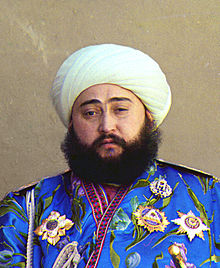- Mohammed Alim Khan
-
Said Mir Mohammed Alim Khan 
Alim Khan, photographed by Prokudin-Gorskii in 1911 Emir of Bukhara Reign January 3, 1911 - August 30, 1920
(9 years, 240 days)Predecessor 'Abd al-Ahad Khan Successor Monarchy Abolished by Red Army invasion. Territory taken over by the Soviet Union House Manghit Dynasty Born 3 January 1880 Died 28 April 1944 (aged 64) Emir Said Mir Mohammed Alim Khan Template:Land-fa (January 3, 1880–April 28, 1944) was the last emir of the Manghit dynasty, the last ruling dynasty of the Emirate of Bukhara in Central Asia. Although Bukhara was a protectorate of the Russian Empire from 1873, the Emir presided over the internal affairs of his emirate as absolute monarch and reigned from January 3, 1911 to August 30, 1920.
At the age of thirteen, Alim Khan was sent by his father Emir Abdulahad Khan to Saint Petersburg for three years to study government and modern military techniques. In 1896, having received formal confirmation as Crown Prince of Bukhara by the Russian government, he returned home.
After two years in Bukhara assisting in his father's administration, he was appointed governor of Nasef region for the next twelve years. He was then transferred to the northern province of Karmana, which he ruled for another two years, until receiving word in 1910 of his father's death.
Alim Khan's rule began with promise. Initially, he declared that he would no longer expect or accept any gifts, and prohibited his officials from demanding bribes from the public, or imposing taxes on their own authority. However, as time went by the Emir's attitude towards bribes, taxes, and state salaries changed. The conflict between the traditionalists and the reformists ended with the traditionalists in control, and the reformers in exile in Moscow or Kazan. It is thought that Alim Khan, who initially favored modernization and the reformists, realised that their eventual goals included no place for either him or his descendants as rulers. Like his predecessors, Alim Khan was a traditional ruler. He toyed with the idea of reform as a tool to keep the clergy in line, and only as long as he saw the possibility of using it to strengthen Manghit rule.[citation needed]
One of the most important Tajik writers, Aini Sadriddin, wrote vivid accounts of life under the Emir. He was whipped for speaking Tajik and later wrote about the life under the Emirs in the Bukhara Executioners ("Jallodon-i Bukhara").
Alim Khan was the only Manghit ruler to add the title of Caliph to his name[citation needed], and was the last direct descendant of Genghis Khan to serve as a national ruler.
In March 1918 activists of the Young Bukharan Movement (Yeni Bukharlylar) informed the Bolsheviks that the Bukharans were ready for the revolution and that the people were awaiting liberation. The Red Army marched to the gates of Bukhara and demanded that the emir surrender the city to the Young Bukharans. As Russian sources report, the emir responded by killing the Bolshevik delegation, along with several hundred Russian supporters of the Bolsheviks in Bukhara and the surrounding territories. The majority of Bukharans did not support an invasion and the ill-equipped and ill-disciplined Bolshevik army fled back to the Soviet stronghold at Tashkent.
However, the emir had won only a temporary respite. As the civil war in Russia wound down, Moscow sent reinforcements to Central Asia. On 2 September 1920, an army of well-disciplined and well equipped Red Army troops under the command of Bolshevik general Mikhail Frunze attacked the city. After four days of fighting, the emir’s citadel (Arc) was destroyed, the red flag was raised from the top of Kalyan Minaret, and the Emir Alim Khan was forced to flee to his base at Dushanbe (in present-day Tajikistan), and finally to Kabul, Afghanistan, where he died in 1944. He is buried at the Shuadoi Solehin cemetery.
Family
Emir's daughter Shukria Raad Alimi worked as a broadcaster in Radio Afghanistan. Shukria Raad left Afghanistan with her family three months after Soviet troops invaded the country in December 1979. With her husband, also a journalist, and two children she fled to Pakistan, and then through Germany to the United States. In 1982 she joined the Voice of America, working for many years as a broadcaster for VOA's Dari Service, editor, program host and producer.[1]
References
- ^ "A Princess-Broadcaster". Voice of America. March 31, 2002. http://www.voanews.com/english/news/a-13-a-2002-03-31-25-1-67420932.html.
Categories:- Emirs
- 1880 births
- 1944 deaths
- History of Uzbekistan
- Ethnic Uzbek people
Wikimedia Foundation. 2010.
